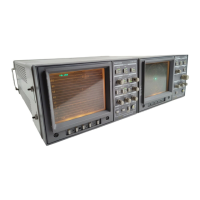1730–Series Checks and Adjustments
5–21
a. Connect a 50Ω precision cable and 50 to 75Ω minimum loss pad from
the leveled sine wave to the CH–A input. Teminate the loop–through in
75Ω.
b. Select EXT REF.
c. Set the leveled sine wave generator to 50 kHz (reference frequency) and
set the output amplitude for a 100 IRE (0.7 V) display amplitude.
d. CHECK – the flat response using the 50 kHz response as a reference.
Changing the frequency of the sine wave generator, check that the
response is within ±2% from 250 kHz to 6 MHz.
e. Change the 1730–Series VERTICAL GAIN to X5.
f. Set the leveled sine wave generator to 50 kHz and set the output
amplitude for a 100 IRE (0.7 V) display amplitude.
g. CHECK – flat response using the 50 kHz response as a reference.
Check that the amplitude is 100 IRE (0.7 V) ±5% from 250 kHz to
6 MHz.
h. Move leveled sine wave generator output to CH–B and terminate the
remaining side of the loop–through INPUT with a 75W termination.
i. Select CH–B INPUT.
j. CHECK – flat response using the 50 kHz response as a reference.
Check that the amplitude is 100 IRE (0.7 V) ±5% from 250 kHz to
6 MHz.
k. Turn off X5 VERTICAL GAIN.
l. CHECK – the flat response using the 50 kHz response as a reference.
Check that the response is within ±2% from 250 kHz to 6 MHz.
14. Check PIX MON OUT Frequency Response
REQUIREMENT – PIX MON OUT Frequency Response with a 50 kHz
reference; within 3% from 250 kHz to 6MHz.
a. Connect a coaxial cable to the + input on the Peak To Peak Detector
Amplifier and connect the other end of the cable to the Peak to Peak
Detector Head.
b. Press the + Input button on the Peak To Peak Detector Amplifier.
c. Adjust the Peak to Peak Detector Amplifier + Input Level control fully
clockwise.

